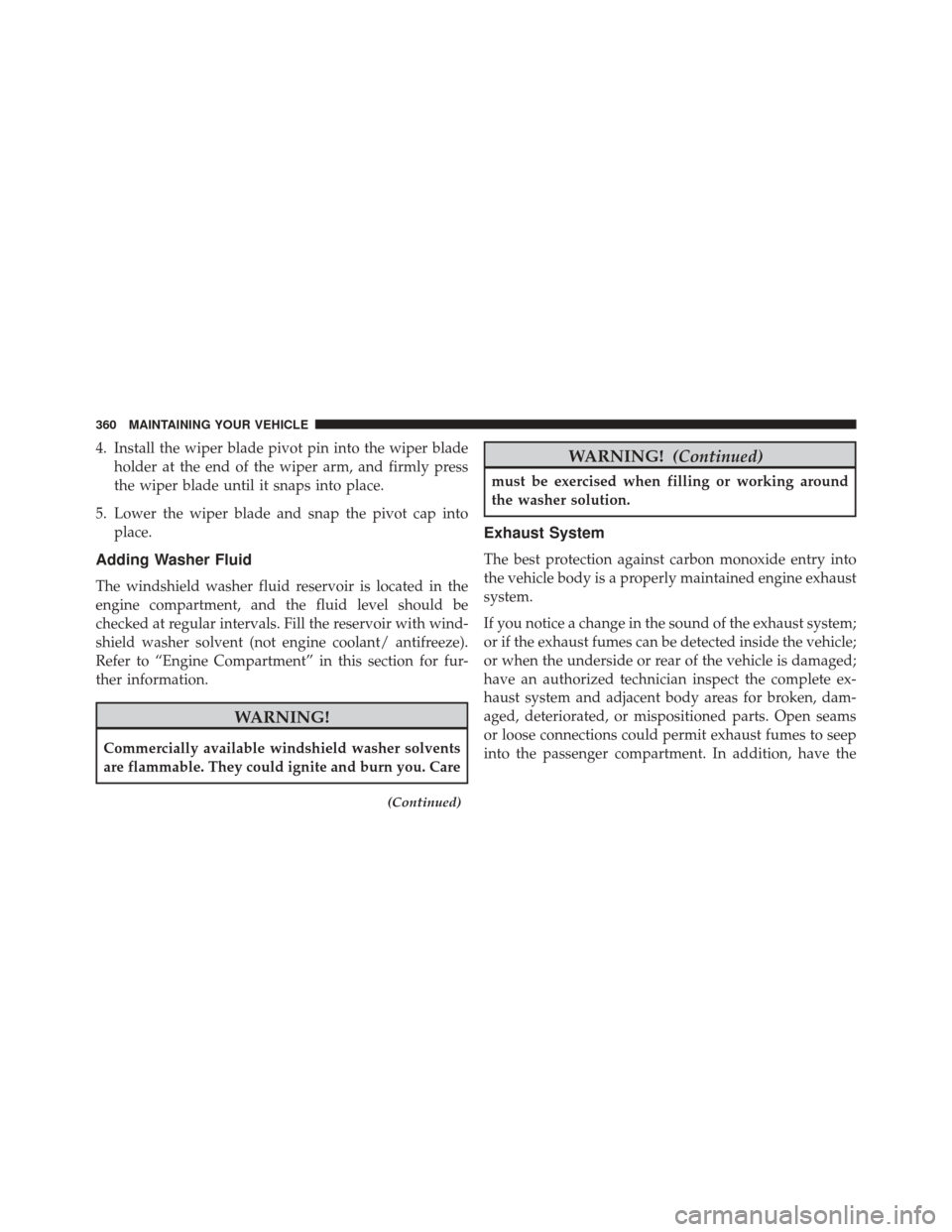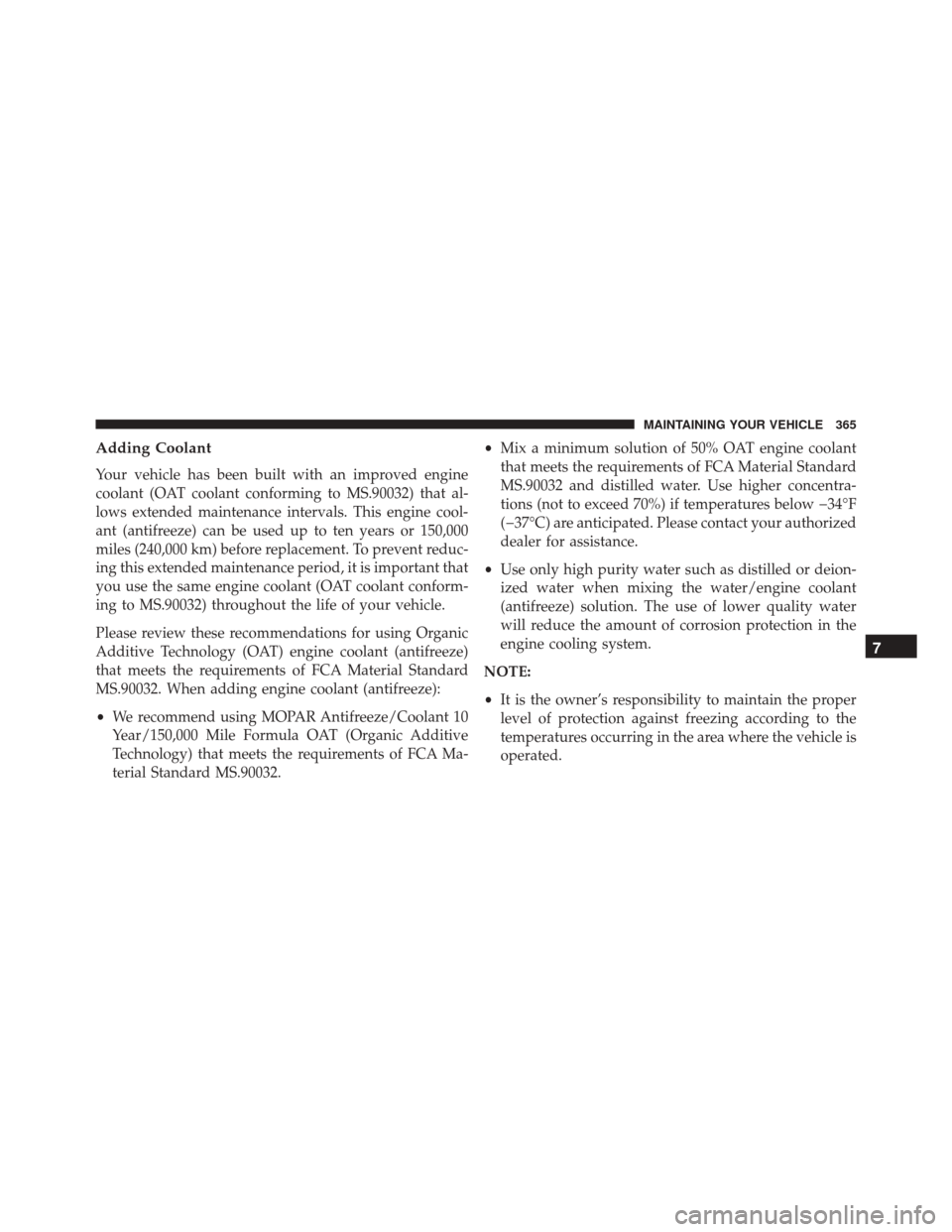2016 FIAT 500 ABARTH coolant level
[x] Cancel search: coolant levelPage 244 of 432

DRIVE (D)
This range should be used for most city and highway
driving. It provides the smoothest upshifts and down-
shifts, and the best fuel economy. The transmission
automatically upshifts through all forward gears. The
DRIVE position provides optimum driving characteris-
tics under all normal operating conditions.
When frequent transmission shifting occurs (such as
when operating the vehicle under heavy loading condi-
tions, in hilly terrain, or traveling into strong head
winds), use the AutoStick shift control (refer to AutoStick
in this section for further information) to select a lower
gear. Under these conditions, using a lower gear will
improve performance and extend transmission life by
reducing excessive shifting and heat buildup.
If the transmission temperature exceeds normal operat-
ing limits, the transmission controller will expand therange of torque converter clutch engagement. This is
done to prevent transmission damage due to overheat-
ing.
During cold temperatures, transmission operation may
be modified depending on engine coolant temperature.
Normal operation will resume once the engine tempera-
ture has risen to a suitable level.
Transmission Limp Home Mode
Transmission function is monitored electronically for
abnormal conditions. If a condition is detected that could
result in transmission damage, Transmission Limp Home
Mode is activated. In this mode, the transmission remains
in third gear regardless of which forward gear is selected.
PARK, REVERSE, and NEUTRAL will continue to oper-
ate. The Malfunction Indicator Light (MIL) may be illu-
minated. Limp Home Mode allows the vehicle to be
driven to an authorized dealer for service without dam-
aging the transmission.
242 STARTING AND OPERATING
Page 362 of 432

4. Install the wiper blade pivot pin into the wiper bladeholder at the end of the wiper arm, and firmly press
the wiper blade until it snaps into place.
5. Lower the wiper blade and snap the pivot cap into place.
Adding Washer Fluid
The windshield washer fluid reservoir is located in the
engine compartment, and the fluid level should be
checked at regular intervals. Fill the reservoir with wind-
shield washer solvent (not engine coolant/ antifreeze).
Refer to “Engine Compartment” in this section for fur-
ther information.
WARNING!
Commercially available windshield washer solvents
are flammable. They could ignite and burn you. Care
(Continued)
WARNING! (Continued)
must be exercised when filling or working around
the washer solution.
Exhaust System
The best protection against carbon monoxide entry into
the vehicle body is a properly maintained engine exhaust
system.
If you notice a change in the sound of the exhaust system;
or if the exhaust fumes can be detected inside the vehicle;
or when the underside or rear of the vehicle is damaged;
have an authorized technician inspect the complete ex-
haust system and adjacent body areas for broken, dam-
aged, deteriorated, or mispositioned parts. Open seams
or loose connections could permit exhaust fumes to seep
into the passenger compartment. In addition, have the
360 MAINTAINING YOUR VEHICLE
Page 367 of 432

Adding Coolant
Your vehicle has been built with an improved engine
coolant (OAT coolant conforming to MS.90032) that al-
lows extended maintenance intervals. This engine cool-
ant (antifreeze) can be used up to ten years or 150,000
miles (240,000 km) before replacement. To prevent reduc-
ing this extended maintenance period, it is important that
you use the same engine coolant (OAT coolant conform-
ing to MS.90032) throughout the life of your vehicle.
Please review these recommendations for using Organic
Additive Technology (OAT) engine coolant (antifreeze)
that meets the requirements of FCA Material Standard
MS.90032. When adding engine coolant (antifreeze):
•We recommend using MOPAR Antifreeze/Coolant 10
Year/150,000 Mile Formula OAT (Organic Additive
Technology) that meets the requirements of FCA Ma-
terial Standard MS.90032. •
Mix a minimum solution of 50% OAT engine coolant
that meets the requirements of FCA Material Standard
MS.90032 and distilled water. Use higher concentra-
tions (not to exceed 70%) if temperatures below �34°F
(�37°C) are anticipated. Please contact your authorized
dealer for assistance.
• Use only high purity water such as distilled or deion-
ized water when mixing the water/engine coolant
(antifreeze) solution. The use of lower quality water
will reduce the amount of corrosion protection in the
engine cooling system.
NOTE:
• It is the owner’s responsibility to maintain the proper
level of protection against freezing according to the
temperatures occurring in the area where the vehicle is
operated.
7
MAINTAINING YOUR VEHICLE 365
Page 369 of 432

rules for your community. To prevent ingestion by ani-
mals or children, do not store ethylene glycol-based
engine coolant in open containers or allow it to remain in
puddles on the ground. If ingested by a child or pet, seek
emergency assistance immediately. Clean up any ground
spills immediately.
Coolant Level
The coolant expansion bottle provides a quick visual
method for determining that the coolant level is ad-
equate. With the engine off and cold, the level of the
engine coolant (antifreeze) in the bottle should be be-
tween the bottom and top lines marked “COLD FILL
RANGE”.
As long as the engine operating temperature is satisfac-
tory, the coolant bottle need only be checked once a
month.When additional engine coolant (antifreeze) is needed to
maintain the proper level, it should be added to the
coolant bottle. Do not overfill.
Points To Remember
NOTE:
When the vehicle is stopped after a few miles/
kilometers of operation, you may observe vapor coming
from the front of the engine compartment. This is nor-
mally a result of moisture from rain, snow, or high
humidity accumulating on the radiator and being vapor-
ized when the thermostat opens, allowing hot engine
coolant (antifreeze) to enter the radiator.
If an examination of your engine compartment shows no
evidence of radiator or hose leaks, the vehicle may be
safely driven. The vapor will soon dissipate.
• Do not overfill the coolant expansion bottle.
7
MAINTAINING YOUR VEHICLE 367
Page 401 of 432

Once A Month Or Before A Long Trip:
Check engine oil level.
Check windshield washer fluid level.
Check the tire inflation pressures and look for unusual
wear or damage.
Check the fluid levels of the coolant reservoir and brake
master cylinder as needed.
Check function of all interior and exterior lights.
Required Maintenance Intervals
Refer to the Maintenance Schedules on the following
pages for required maintenance.At Every Oil Change Interval As Indicated By OilChange Indicator System:
Change oil and filter.
Rotate the tires. Rotate at the first sign of irregular
wear, even if it occurs before the oil indicator sys-
tem turns on.
Inspect battery and clean and tighten terminals as
required.
Inspect brake pads, shoes, rotors, drums, hoses and
park brake.
Inspect engine cooling system protection and hoses.
Inspect exhaust system.
Inspect engine air cleaner if using in dusty or off-road
conditions.
8
MAINTENANCE SCHEDULES 399
Page 417 of 432

Audio Systems (Radio).....................194
Automatic Dimming Mirror ...................88
Automatic Door Locks ......................23
Automatic Temperature Control (ATC) ..........216
Automatic Transaxle ........................11
Automatic Transmission ..............235, 371, 373
Adding Fluid ...................... .372, 373
Fluid And Filter Changes ..................373
Fluid Change ......................... .373
Fluid Level Check ...................... .372
Fluid Type ........................... .396
Gear Ranges .......................... .238
Special Additives ...................... .372
Autostick .............................. .243
Battery ............................ .155, 352
Charging System Light ...................155
Jump Starting ......................... .331
Keyless Transmitter Replacement (RKE) ........19Belts, Seat
...............................77
Body Mechanism Lubrication .................357
B-Pillar Location ......................... .269
Brake Assist System ...................... .255
Brake Fluid ......................... .394, 396
Brake, Parking .......................... .249
Brakes ................................ .368
Brake System ........................ .253, 368
Anti-Lock (ABS) ....................... .254
Master Cylinder ....................... .369
Parking ............................. .249
Warning Light ........................ .153
Brake/Transmission Interlock .................236
Bulb Replacement ..................... .388, 389
Bulbs, Light .......................... .79, 388
Capacities, Antifreeze (Engine Coolant) ..........393
Capacities, Fluid ......................... .393
10
INDEX 415
Page 419 of 432

Cooling System.......................... .363
Adding Coolant (Antifreeze) ...............365
Coolant Level ..................... .363, 367
Disposal Of Used Coolant .................366
Drain, Flush, And Refill ...................363
Inspection ........................... .367
Points To Remember ..................366, 367
Pressure Cap ......................... .366
Selection Of Coolant (Antifreeze) .........364, 394
Corrosion Protection ...................... .373
Cruise Light ......................... .175, 177
Cupholders ............................ .127
Customer Assistance ...................... .404
Customer Programmable Features .............197
Data Recorder, Event .......................54
Daytime Running Lights ....................102
Dealer Service ........................... .347
Defroster, Windshield ....................77, 215 Diagnostic System, Onboard
.................344
Dipsticks Automatic Transmission ..................372
Disarming, Security System ...................15
Disposal Antifreeze (Engine Coolant) ................366
Door Ajar .......................... .159, 160
Door Ajar Light ...................... .159, 160
Door Locks ..............................21
Door Locks, Automatic ......................23
Downshifting ........................... .234
Driving Through Flowing, Rising, Or Shallow Standing
Water ............................... .246
Electrical Power Outlets .....................123
Electric Remote Mirrors ......................89
Electronic Brake Control System ...............254
Brake Assist System .....................255
10
INDEX 417